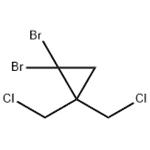1,1-Dibromo-2,2-bis(chloromethyl)cyclopropane may be used as a starting material in the synthesis of [1.1.1]-propellane and ((3-ethynylbicyclo[1.1.1]pentan-1-yl)ethynyl)trimethylsilane.
1000 ml 1,1-bis(chloromethyl)-2,2-dibromocyclopropane was added to a vigorously stirred mixture within 10-15 min, which contains bromoform (370 ml, 4.24 mol), 3-chloro-2-chloromethyl-1-propane (250 g, 2.0 mol), 10 g benzyltriethylammonium chloride, 8 ml ethanol and 200 ml methylene chloride . The temperature was maintained between 25°-35° C. After overnight stirring, 500 ml methylene chloride was added and the thick black mixture was allowed to separate into layers. The top aqueous layer was removed and the bottom layer was gently washed with water (500 ml). 500 ml water was then added and well shaken. Separated the organic phase, treated the residual emulsion with solid sodium chloride and filtered through Celite. All aqueous layers were washed with methylene chloride. The organic extracts were combined, dried over magnesium sulfate, and filtered through Celite. Concentration and vacuum distillation gave the mixture of starting material and black-brown residue which was distilled on a Kugel-Rohr giving semicrystalline fraction containing the product. Crystallization from 400 ml of pentane from a dry ice-acetone bath gave the white wet crystals. The crude product was dissolved in 400 ml of penfane, then 7.5 g silica gel was added. Filtered and low temperature recrystallized again. Finally, obtain the product (1,1-DIBROMO-2,2-BIS(CHLOROMETHYL)CYCLOPROPANE )
1,1-Dibromo-2,2-bis(chloromethyl)cyclopropane is a halogenated cyclopropane derivative. It has been reported to be synthesized from 3-chloro-2-(chloromethyl)-1-propene. It is formed as an intermediate during the synthesis of [1.1.1]propellane by Szeimies method.



